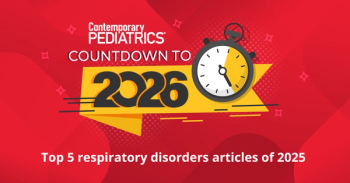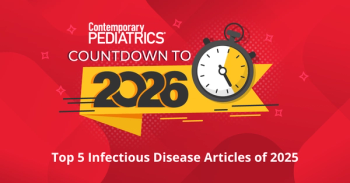
- Vol 36 No 4
- Volume 36
- Issue 4
Evaluation, treatment, and prevention of obesity in community settings
A unique program addresses the crisis of pediatric and adolescent obesity and its effects on child and family health in the state of Pennsylvania.
It is not easy to establish and maintain good dietary, physical activity, sleep, screen time, mental health, and the other habits that promote ideal weight and waist circumference. Even though patients and families cannot always do the “right” things all the time, small improvements can make a difference in body mass index (BMI). In addition, success in one area can be a boon to success in others, leading to a healthier lifestyle overall.
The Pennsylvania Chapter, American Academy of Pediatrics (PA AAP), developed a unique program to address the many facets of pediatric and adolescent obesity. Through the “EPIC: Pediatric Obesity: Evaluation, Treatment, and Prevention in Community Settings” program, locally based, physician-registered dietitian/nutritionist (RDN) teams bring a live, interactive update on pediatric overweight and obesity to community-based healthcare providers. The program links together a wide array of treatment options to best help patients and families. The program model offers a unique opportunity to foster a team approach to address a complex health issue.
Obesity crisis nationally and in Pennsylvania
Obesity is a significant health problem for Pennsylvania and the nation. In Pennsylvania in 2017, 31.6% of adults had obesity (BMI, >30), a steady increase since 1990 when the rate was 13.7%. Child and adolescent obesity data mirror the adult outlook, with one-third of children having overweight or obesity (Table 1).
Nationally, in 2001, the US Surgeon General released a “Call to Action” that labeled obesity an epidemic. It pointed out that the nation did not meet the Healthy People 2010 goals for obesity and that “the statistics on overweight and obesity have steadily headed in the wrong direction.”1 In 2010, the US Surgeon General revisited obesity with the report “The Surgeon General’s Vision for a Healthy and Fit Nation.” This report included a call to look beyond BMI numbers to promote “an optimal level of health and well-being.”2
Pediatric practices are an essential community structure to which parents turn for guidance in establishing healthy habits and combatting obesity for their children. Research continues to find that provider understanding of appropriate clinical care for obesity is not current with evidence-based recommendations3 such as the AAP treatment algorithm.4
Partners for addressing pediatric obesity
The PA AAP and the Pennsylvania Department of Health (PA DOH) have a history of working together to promote child and family health. An educational model for practice-based change was cooperatively utilized going back to 1996. This model, “Educating Physicians In their Communities (EPIC),” was developed by the PA AAP in 1996 to bring live, free, continuing medical education (CME) to the entire practice team in primary care sites. Educational sessions are presented by a 2-person team of a pediatrician or family medicine physician and a subject matter expert. The first EPIC program, EPIC: Immunization, paired a physician with a PA DOH immunization nurse. This program was successfully presented across Pennsylvania from 1996 to 2014. It established an effective PA AAP/PA DOH vehicle to pool resources to address a key health topic. EPIC programs on child abuse, early hearing screening, breastfeeding, oral health, and other topics have followed.
In considering additional ways that Pennsylvania could address obesity, the PA AAP and the PA DOH agreed that an EPIC: Pediatric Obesity program should be developed. The 2-person presenter team consists of a physician and an RDN. Two additional partners were enlisted: the PA Academy of Nutrition and Dietetics and the PA Academy of Family Physicians and Foundation. Funding for EPIC: Pediatric Obesity has been almost entirely provided by the PA DOH as part of the Centers for Disease Control and Prevention (CDC) Preventive Health and Health Services Block Grant. The National Network of Libraries of Medicine provided a small grant for a follow-up webinar for sites that hosted the EPIC: Pediatric Obesity program.
Plan of action
EPIC: Pediatric Obesity brings comprehensive education on obesity directly to physicians and the entire staff at practices, Grand Rounds, residency training, school nurses, professional conferences, and other sites. Presenters are professionals in practice in the local area, familiar with the demographics and needs of the community, helping them to make a connection with the program host sites. Presenters are recognized as experts in the community. They are also a statewide sentinel network alert to emerging problems and reimbursement concerns.
From 2011 to 2018, EPIC: Pediatric Obesity provided 363 events, reaching 980 sites, with 8034 participants, in 61 of Pennsylvania’s 67 counties. The program is ongoing. Programs are typically 1 hour in length, free for participants, and are accredited to provide American Medical Association (AMA) Category 1 credits. Programs are characteristically live but occasionally are held through webinars to expand reach. Presenters receive an honorarium for each program.
Obesity-related topics such as effectively introducing new foods and treating patients with severe obesity were presented in detail on 11 continuing education webinars as part of the PA AAP’s “Let’s Talk” webinar series. The free, CME/CEU “Let’s Talk” webinars are offered to sites that hosted an EPIC: Pediatric Obesity or other PA AAP EPIC program, PA AAP members, members of the PA Academy of Nutrition and Dietetics, Pennsylvania’s regional Health Alliances, nurses, and others. The webinars sustain quality improvement engagement with the practices, as well as keep them up to date with the latest research.
Obesity assessment and interventions
Numerous factors contribute to individuals’ overweight and obesity. Despite complex causes, clear evidence-based interventions have been identified to treat and reduce childhood obesity. EPIC: Pediatric Obesity is based on the 2007 AAP Expert Committee Guidelines5 and subsequent treatment algorithm4 published in 2015. For an individual patient, this includes assessment and consideration of intervention regarding food, diet, beverages, sleep, mental health, screen time, physical activity, and food insecurity.
EPIC: Pediatric Obesity educates audiences about how to assess these components, provides tools to assist, and identifies possible interventions. Presenters demonstrate motivational interviewing to develop goals with an individual patient and family. Programs share coding and reimbursement tips. Sites are encouraged to identify a wellness champion who can be the site’s “information center” for local resources on food insecurity, summer feeding programs, physical activity programs, and other obesity-prevention and treatment services.
Parents are the role models and the family is the treatment unit. Parents benefit from education about lifelong implications of early habits that lead to healthy lifestyles and the importance of “starting off right.” Parent knowledge cannot be taken for granted. Education is needed regarding portion sizes especially for toddlers, alternatives to food for reward and punishment, and understanding food labels. Healthcare providers should not assume parents know how to select and prepare many vegetables and fruits, or that they have been taught how to cook. The RDNs are invaluable partners. These RDN presenters share tips healthcare providers can use immediately and discuss the impact RDNs can have on patient outcomes.
Constant evolution
To stay current and useful, EPIC: Pediatric Obesity continually integrates feedback and new material.
Additions have included:
· The impact of sleep on weight and mental health with a “Let’s Talk” webinar and community advocacy regarding later school start times for adolescents in accordance with AAP6 and CDC7 policy recommendations;
· Food insecurity screening and resources including the AAP’s toolkit8;
· “Person-first” language regarding children with obesity;
· Weight bias and stigmatization including a “Let’s Talk” webinar, aligned with AAP policy9;
· Incorporation of cultural background and habits; and
· Promoting physical activity for children who have obesity and are deconditioned, including a “Let’s Talk” webinar.
See Tables 2 through 4 for more information and helpful resources.
Evaluation
Program participants completed pre-surveys and post-surveys at the time of each live and webinar program. Pretest and posttest data show that EPIC: Pediatric Obesity succeeded in providing relevant interventions to physicians and other healthcare professionals. Participants developed a broader awareness of community-based resources, increased knowledge and skills regarding identifying childhood obesity comorbidities, and broadened their ability to provide anticipatory guidance for families on nutrition and physical activity (Figures 1 and 2.)
Limitations of the EPIC: Pediatric Obesity evaluation include working statewide and without access to patient data. Obesity interrelates with social and economic factors beyond the program’s control. Also, the program cannot realistically expect dramatic, immediate transformation of patients, families, or communities resulting from the 1-hour EPIC program.
An important impact of the program is its effect on the 64 physicians and 72 RDNs who presented at least 1 EPIC: Pediatric Obesity program. Presenters work with this program because they are passionate about child health. They appreciate the training and updates, and benefit from online networking and discussion. They learn about their community by visiting different sites and interacting with audiences. Presenters also enjoy involvement with their local AAP chapter and collaboration with the PA DOH.
Key takeaways
EPIC: Pediatric Obesity is a unique, innovative approach to the prevention and treatment of pediatric obesity. The program has existed in Pennsylvania since 2011 and could be replicated in other areas. It has positively influenced primary care, residency training, school nurses, and other professional groups with practical, current obesity information tailored to each site’s specific needs. It communicates the benefits of partnering with RDNs.
Obesity is a complex disease with many factors to assess and transform. With an individual patient or family, any one aspect of diet, beverages, sleep, mental health, activity, screen time, or food insecurity may be the most fruitful avenue for intervention. The program finds motivational interviewing to be a productive and efficient way to set goals and track progress.
Funding for the program is slated to end in June 2019 as the PA DOH pursues other obesity initiatives. The PA AAP hopes to find avenues to maintain obesity prevention and treatment work. Additionally, the PA AAP is interested in furthering work on food insecurity and its connection with obesity.
Acknowledgements: Assistance with evaluation: Ann Kanof, MS. Developers of EPIC model: Jerold Aronson, MD, MPH, FAAP; Alan Kohrt, MD, FAAP; Lois Kohrt. PA DOH: Tiffany Bransteitter, MSW; Amy Flaherty, MA; Serina Gaston, MED, CHES. Physician and RDN EPIC: Pediatric Obesity presenters, with exceptional contributions from William Cochran, MD, FAAP; Mark Diamond, MD, FAAP; Laura Frank, MPH, MED, PHD, RD, LDN, CRC; Ann Marie Kuchera, MS, MA, RD, LPC; Marsha Novick, MD; Mary Ann Rigas, MD, FAAP; Margaret Maher Rowe, MS, RD, LDN, FADA, FAND; Denise Salerno, MD, FAAP. PA Academy of Nutrition and Dietetics, especially Lisa Ann Jones, MA, RD, LDN. PA AAP: Kristin Haegele-Hill, MS; Aleksandra McDonnell, MSN, RN, CRNP; Annette Myarick; Dottie Schell, BS, RN, CLC, CCE; Sharon Shepherd; Libby Ungvary, MED; Suzanne Yunghans, MB MGT.
Articles in this issue
over 6 years ago
Probiotics in children: To use or not to use?over 6 years ago
Riddle me this: Probiotics in newborns and childrenover 6 years ago
Dr Farber’s parting wordsover 6 years ago
E-cigarettes beat out nicotine replacement to quit smokingover 6 years ago
Doctors share ethical issues that worry them mostover 6 years ago
Excessive screen time hinders optimum developmentover 6 years ago
Pediatric urgent care vs the medical homeover 6 years ago
Pediatric truth-telling: Omission vs deceptionover 6 years ago
Adolescent privacy and the EHRover 6 years ago
Child with punctate opacities in the colonNewsletter
Access practical, evidence-based guidance to support better care for our youngest patients. Join our email list for the latest clinical updates.




